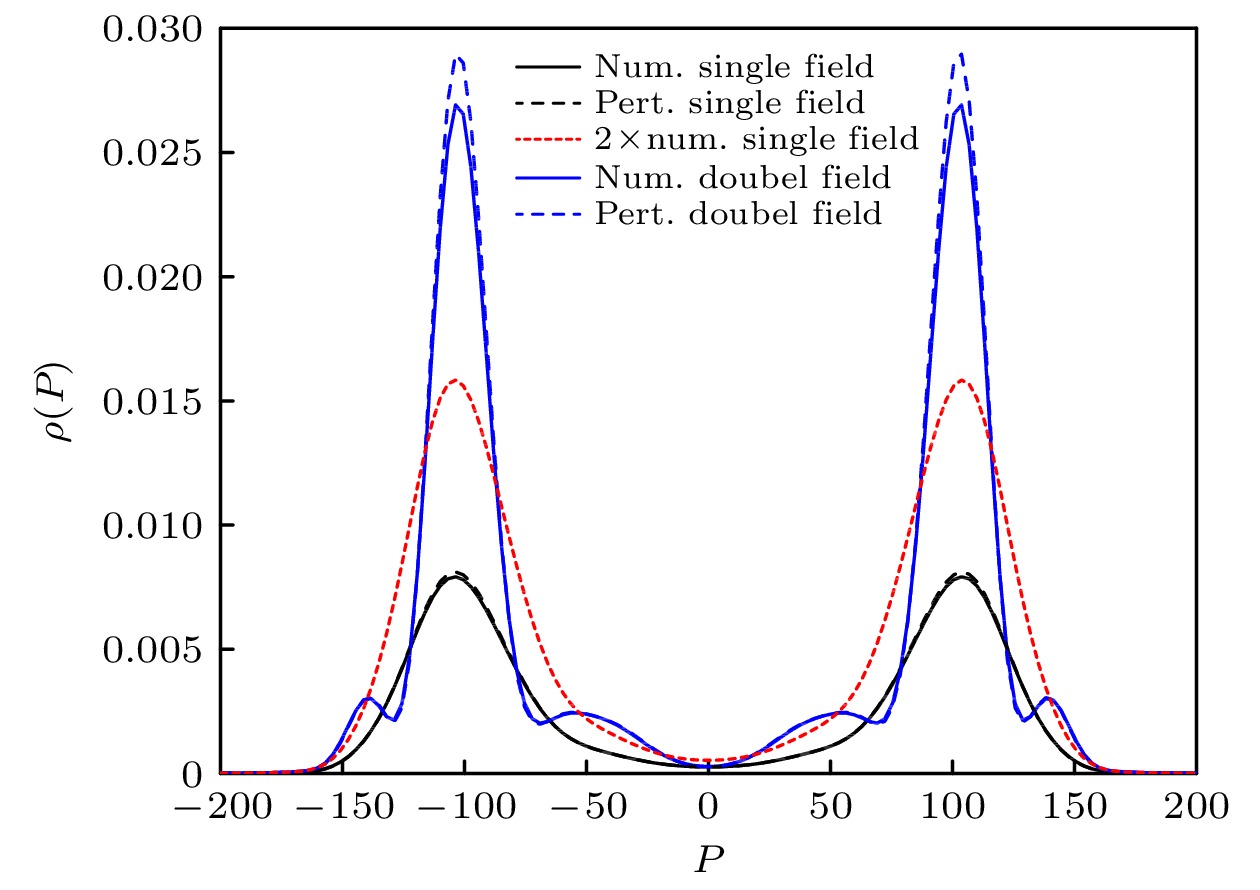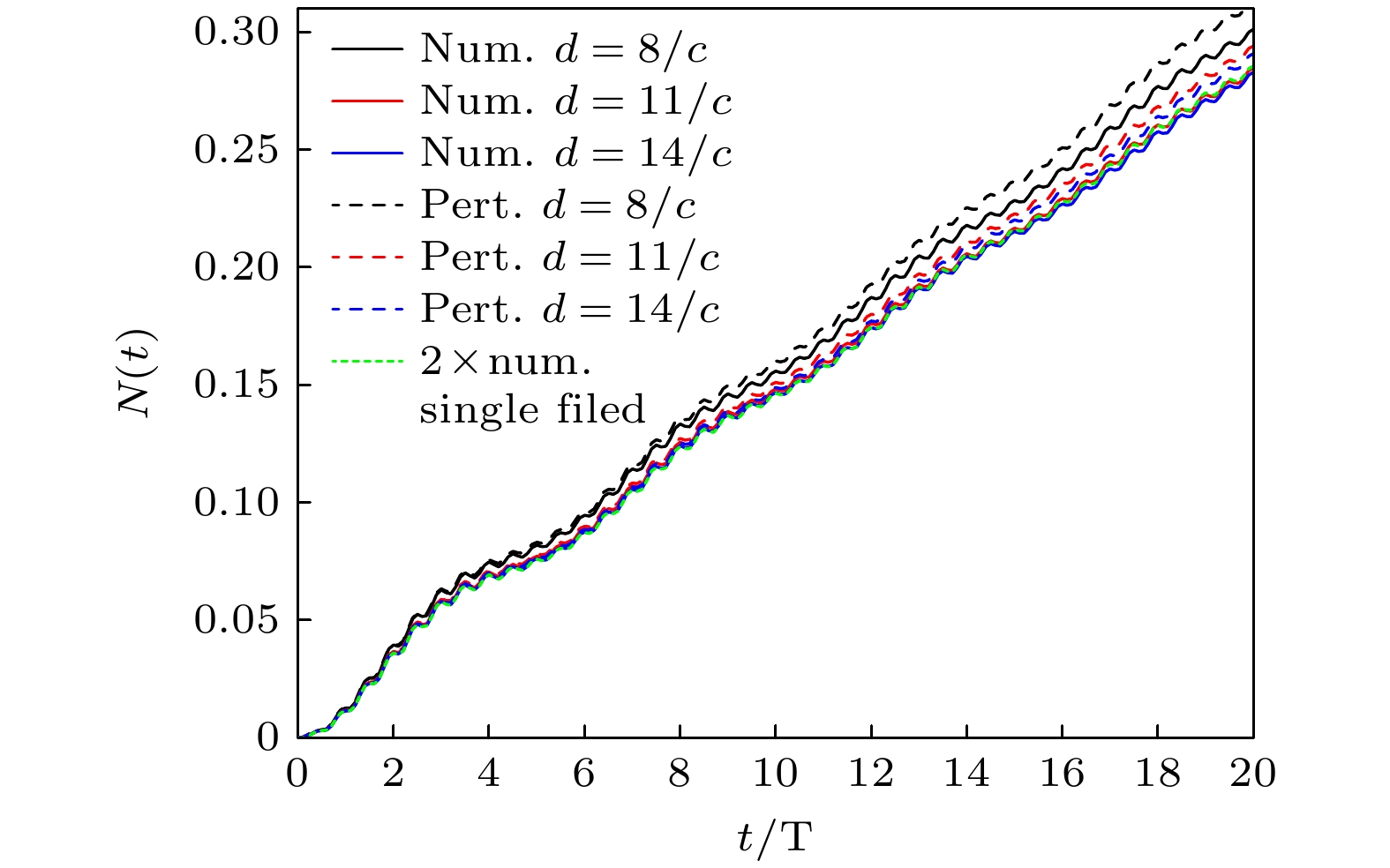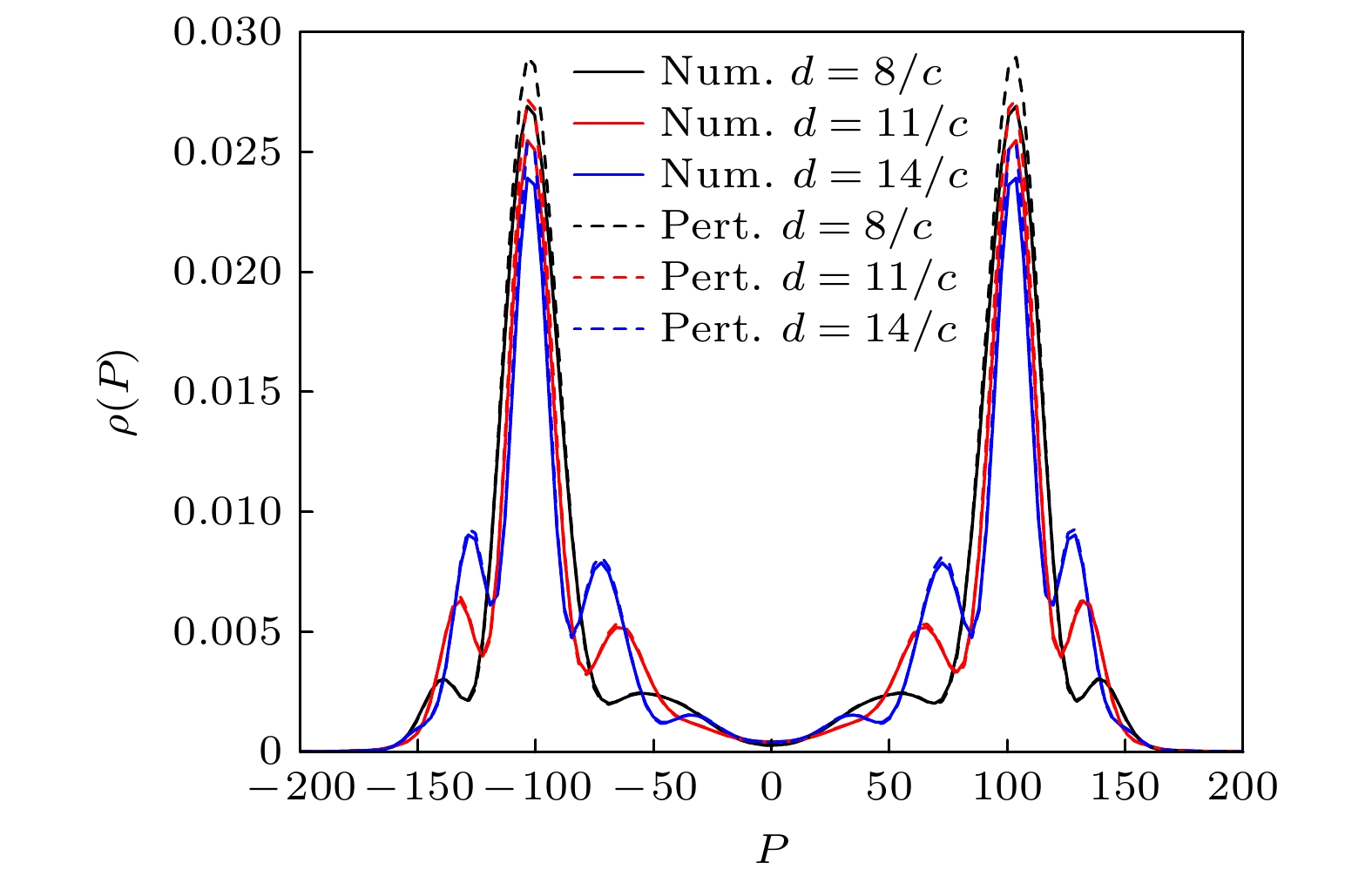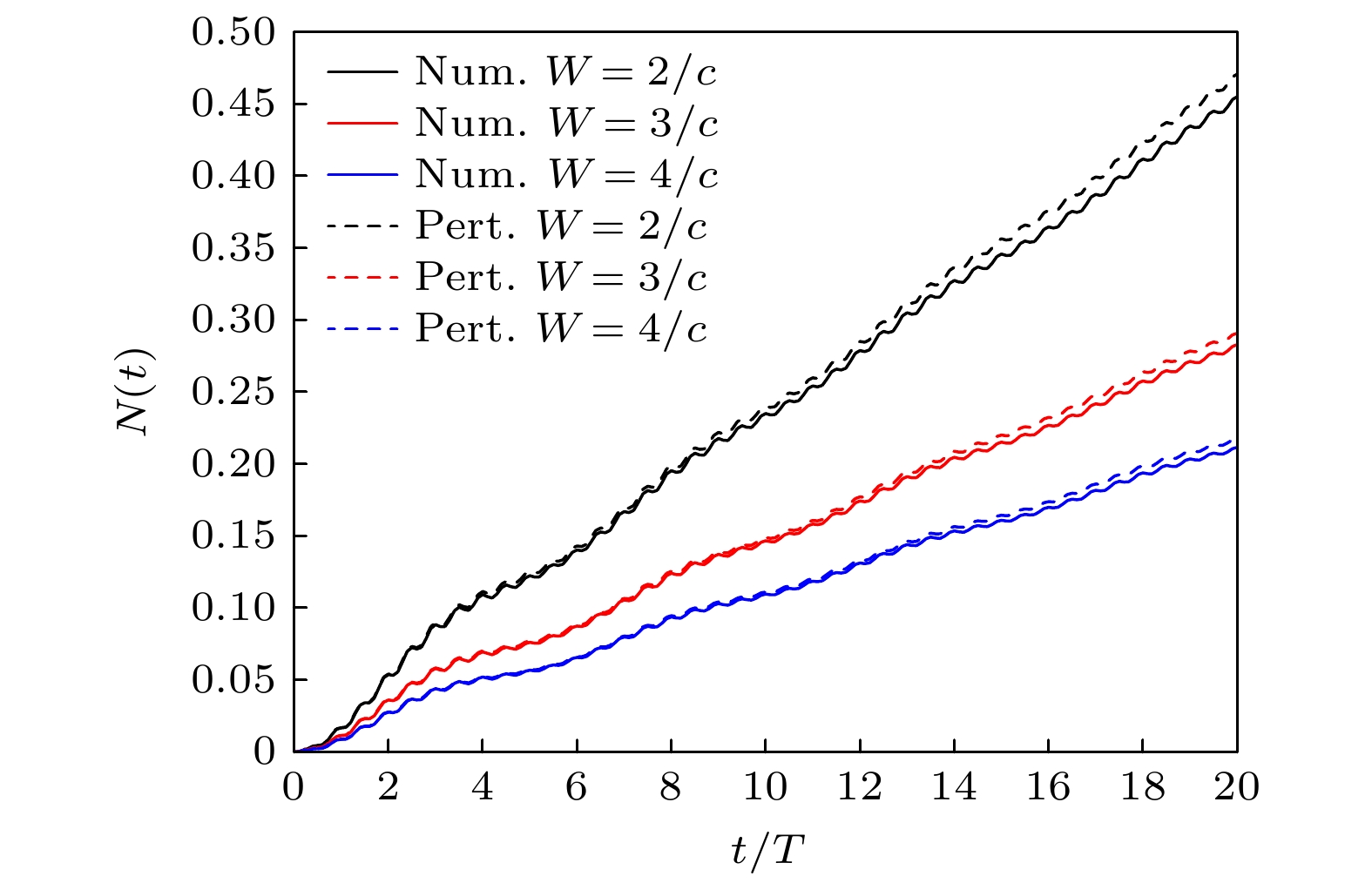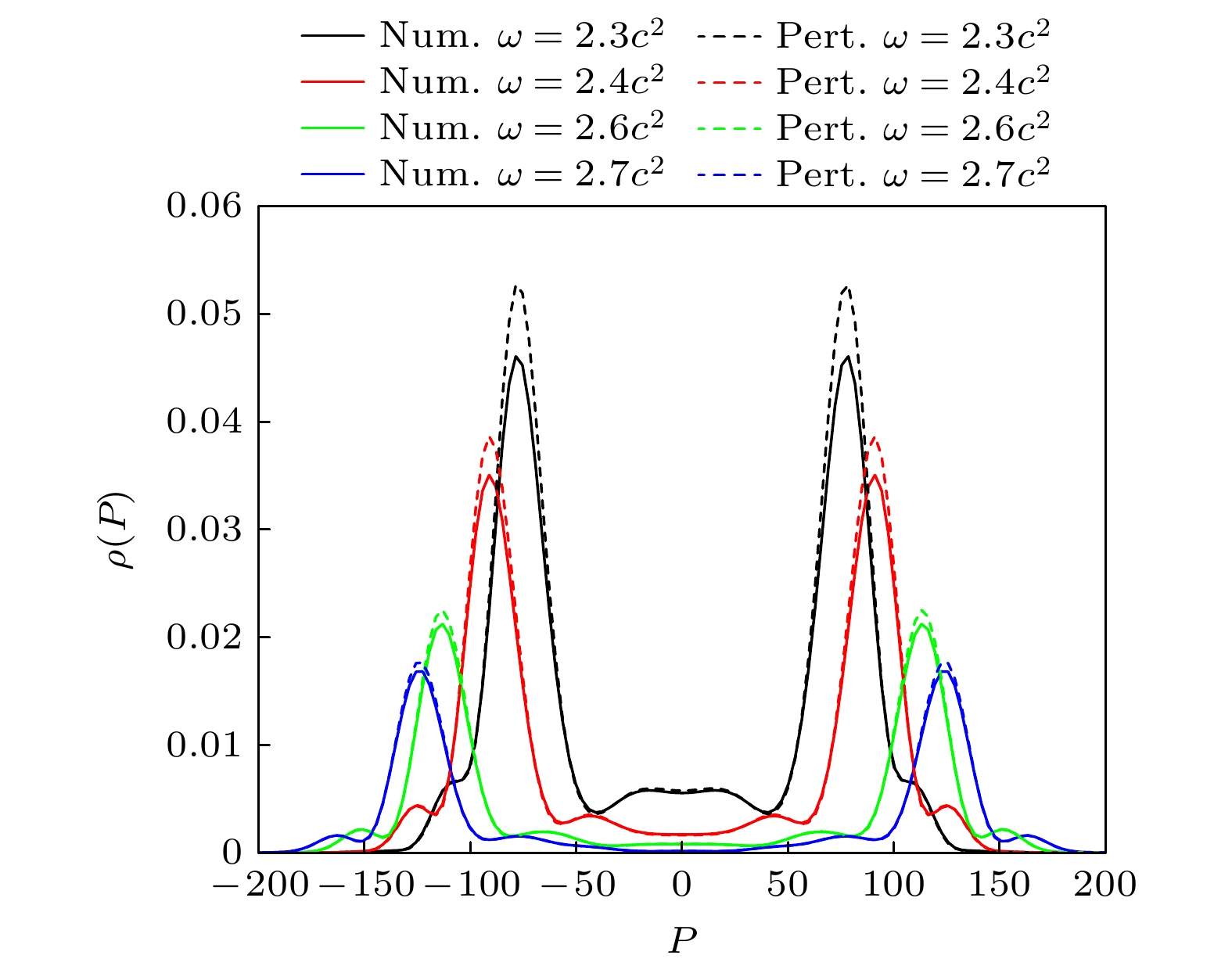-
We investigate an important aspect of electron-positron pair creation from vacuum in the presence of a strong background field, where the combined field plays a key role in the pair creation process. By utilizing computational quantum field theory, we explore electron-positron pair creation induced by double-located oscillating electric fields by numerically solving the Dirac equation in full spacetime dimensions. We demonstrate theoretically that computational quantum field theory is equivalent to the first-order time-dependent perturbation theory for single-photon transition pair creation in a spatially inhomogeneous and time-dependent electric field, and verify their equivalence through numerical simulations of pair creation in double-located oscillating fields. We show some interesting results about the periodic oscillation of the momentum spectrum structure of the created particle and the asymmetric multi-photon pair creation process due to the interference between two fields. By using first-order time-dependent perturbation theory, we find that the periodic oscillation in the momentum distribution of the created particle is affected by the field width, the field frequency and the distance between two fields. The period of the oscillation of momentum spectrum structure is changed by the distance between two fields, while the field width has an influence on both the difference between the peak and valley of the momentum spectra and the width of the momentum space available to the created particle. Increasing the frequency of the electric field results in larger momentum for the created particle pairs, while correspondingly reducing the coupling matrix element $ \langle p|V|n \rangle $ and diminishing the probability of electron-positron pair creation.The interference between two fields significantly enhances the yield of pair numbers for small distances between two fields. When the distance is too large, the number of pairs created by double oscillating fields is twice that created by a single field, and the enhancement is vanished. When the distance between two fields increases, the period of oscillation decreases. In turn, the creation of electron-positron pairs can become more monochromatic in momentum (energy), while the number of pairs created remains almost constant. As the electric field broadens, the yield of the created pairs decreases for constant potential height. Increasing the field width will reduce the number of particles for each momentum and narrow the momentum space of the created particle. Increasing the field frequency leads to the reduction of the coupling matrix element $ \langle p|V|n \rangle $ and subsequently reduces the total number of electron-positron pairs created. The field profile parameters such as frequency, width, and distance between two fields can be utilized to select a specific momentum (energy) of particles in future electron-positron pair creation experiments.[1] Xie B S, Li Z L, Tang S 2017 Matter Radiat. Extremes 2 225
 Google Scholar
Google Scholar
[2] Fedotov A, Ilderton A, Karbstein F, King B, Seipt D, Taya H, Torgrimsson G 2023 Phys. Rep. 1010 1
 Google Scholar
Google Scholar
[3] Sauter F 1931 Z. Physik 69 742
 Google Scholar
Google Scholar
[4] Heisenberg W, Euler H 1936 Z. Physik 98 714
 Google Scholar
Google Scholar
[5] Schwinger J 1951 Phys. Rev. 82 664
 Google Scholar
Google Scholar
[6] Brezin E, Itzykson C 1970 Phys. Rev. D 2 1191
 Google Scholar
Google Scholar
[7] Kim S P, Page D N 2002 Phys. Rev. D 65 105002
 Google Scholar
Google Scholar
[8] Schützhold R, Gies H, Dunne G V 2008 Phys. Rev. Lett. 101 130404
 Google Scholar
Google Scholar
[9] Schneider C, Torgrimsson G, Schützhold R 2018 Phys. Rev. D 98 085009
 Google Scholar
Google Scholar
[10] Abdukerim N, Li Z L, Xie B S 2013 Phys. Lett. B 726 820
 Google Scholar
Google Scholar
[11] Li Z L, Lu D, Xie B S, Fu L B, Liu J, Shen B F 2014 Phys. Rev. D 89 093011
 Google Scholar
Google Scholar
[12] Kohlfürst C, Gies H, Alkofer R 2014 Phys. Rev. Lett. 112 050402
 Google Scholar
Google Scholar
[13] Gong C, Li Z L, Xie B S, Li Y J 2020 Phys. Rev. D 101 016008
 Google Scholar
Google Scholar
[14] Hebenstreit F, Alkofer R, Gies H 2010 Phys. Rev. D 82 105026
 Google Scholar
Google Scholar
[15] Hebenstreit F, Alkofer R, Gies H 2011 Phys. Rev. Lett. 107 180403
 Google Scholar
Google Scholar
[16] Li Z L, Lu D, Xie B S 2015 Phys. Rev. D 92 085001
 Google Scholar
Google Scholar
[17] Li Z L, Li Y J, Xie B S 2017 Phys. Rev. D 96 076010
 Google Scholar
Google Scholar
[18] Kohlfürst C, Alkofer R 2018 Phys. Rev. D 97 036026
 Google Scholar
Google Scholar
[19] Kohlfürst C 2019 Phys. Rev. D 99 096017
 Google Scholar
Google Scholar
[20] Cheng T, Su Q C, Grobe R 2010 Contemp. Phys. 51 315
 Google Scholar
Google Scholar
[21] Jiang M, Su W, Lu X, Sheng Z M, Li Y T, Li Y J, Zhang J, Grobe R, Su Q C 2011 Phys. Rev. A 83 053402
 Google Scholar
Google Scholar
[22] Su Q C, Su W, Lü Q Z, Jiang M, Lu X, Sheng Z M, Grobe R 2012 Phys. Rev. Lett. 109 253202
 Google Scholar
Google Scholar
[23] Jiang M, Lü Q Z, Sheng Z M, Grobe R, Su Q C 2013 Phys. Rev. A 87 042503
 Google Scholar
Google Scholar
[24] Lü Q Z, Li Y J, Grobe R, Su Q C 2013 Phys. Rev. A 88 033403
 Google Scholar
Google Scholar
[25] 林南省, 韩禄雪, 江淼, 李英骏 2018 物理学报 67 133401
 Google Scholar
Google Scholar
Lin N S, Han L X, Jiang M, Li Y J 2018 Acta Phys. Sin. 67 133401
 Google Scholar
Google Scholar
[26] Lü Q Z, Su Q C, Grobe R 2018 Phys. Rev. Lett. 121 183606
 Google Scholar
Google Scholar
[27] Su Q C, Grobe R 2019 Phys. Rev. Lett. 122 023603
 Google Scholar
Google Scholar
[28] Zhou X X, Li C K, Jiang M, Lin N S, Li Y J 2019 EPL 128 10001
 Google Scholar
Google Scholar
[29] Su D D, Li Y T, Lü Q Z, Zhang J 2020 Phys. Rev. D 101 054501
 Google Scholar
Google Scholar
[30] Gong C, Li Z L, Li Y J, Xie B S 2020 Phys. Rev. A 101 063405
 Google Scholar
Google Scholar
[31] Zhou X X, Li C K, Lin N S, Li Y J 2021 Phys. Rev. A 103 012229
 Google Scholar
Google Scholar
[32] Su D D, Li Y T, Su Q C, Grobe R 2021 Phys. Rev. D 103 074513
 Google Scholar
Google Scholar
[33] Li C K, Su D D, Li Y J, Su Q C, Grobe R 2023 EPL 141 55001
 Google Scholar
Google Scholar
[34] Dumlu C K 2009 Phys. Rev. D 79 065027
 Google Scholar
Google Scholar
[35] Li Z L, Xie B S, Li Y J 2019 Phys. Rev. D 100 076018
 Google Scholar
Google Scholar
[36] Li Z L, Gong C, Li Y J 2021 Phys. Rev. D 103 116018
 Google Scholar
Google Scholar
[37] Yoon J W, Kim Y G, Choi I W, Sung J H, Lee H W, Lee S K, Nam C H 2021 Optica 8 630
 Google Scholar
Google Scholar
[38] ELI BEAMLINES FACILITY, http://www.extreme-light-infrastructure.eu/
[39] Burke D L, Field R C, Smith G H, Spencer J E, Walz D, Berridge S C, Bugg W M, Shmakov K, Weidemann A W, Bula C, McDonald K T, Prebys E J, Bamber C, Boege S J, Koffas T, Kotseroglou T, Melissinos A C, Meyerhofer D D, Reis D A, Ragg W 1997 Phys. Rev. Lett. 79 1626
 Google Scholar
Google Scholar
[40] Pike O, Mackenroth F, Hill E, Rose S J 2014 Nat. Photon. 8 434
 Google Scholar
Google Scholar
[41] Blackburn T G, Marklund M 2018 Plasma Phys. Contr. F. 60 054009
 Google Scholar
Google Scholar
[42] Yu J Q, Lu H Y, Takahashi T, Hu R H, Gong Z, Ma W J, Huang Y S, Chen C E, Yan X Q 2019 Phys. Rev. Lett. 122 014802
 Google Scholar
Google Scholar
[43] Golub A, Chávez S V, Ruhl H, Müller C 2021 Phys. Rev. D 103 016009
 Google Scholar
Google Scholar
[44] MacLeod A J, Hadjisolomou P, Jeong T M, Bulanov S V 2023 Phys. Rev. A 107 012215
 Google Scholar
Google Scholar
[45] Narozhny N B, Bulanov S S, Mur V D, Popov V S 2004 Phys. Lett. A 330 1
[46] Dunne G V, Gies H, Schüzhold R 2009 Phys. Rev. D 80 111301
 Google Scholar
Google Scholar
[47] Bulanov S S, Mur V D, Narozhny N B, Nees J, Popov V S 2010 Phys. Rev. Lett. 104 220404
 Google Scholar
Google Scholar
[48] Aleksandrov I A, Plunien G, Shabaev V M 2017 Phys. Rev. D 96 076006
 Google Scholar
Google Scholar
[49] Jiang M, Grobe R, Su Q C 2023 Phys. Rev. A 108 022813
 Google Scholar
Google Scholar
-
图 1 正负电子对数量随时间的变化, 实线和虚线分别表示计算量子场论的结果和一阶含时微扰理论的结果, 蓝色线表示双振荡场产生的粒子对数量, 黑色线表示单振荡场产生的粒子对数量, 红色点线表示单振荡场产生的粒子对数量的2倍, 其中V1 = V2 = 0.75c2, W1= W2 = 3/c, d = 8/c, ω = 2.5c2, T = 2π/ω
Figure 1. Time evolution of the electron-positron pairs, the results calculated by the computational quantum field theory and the first-order time-dependent perturbation theory are represented by the solid line and the dashed line, respectively. The electron-positron pairs created by double oscillating filed is represented by blue line, the electron-positron pairs created by single oscillating field is represented by black line, and the twice of the pairs created by single oscillating field is represented by the red dotted line. Here, V1 = V2 = 0.75c2, W1 = W2 = 3/c, d = 8/c, ω = 2.5c2, T = 2π/ω.
图 2 正负电子对的动量分布, 实线和虚线分别表示计算量子场论的数值结果和一阶含时微扰理论的结果. 其中V1 = V2 = 0.75c2, W1 = W2 = 3/c, d = 8/c, ω = 2.5c2, t = 20T = 40π/ω
Figure 2. Momentum spectra of the created electron-positron pairs, the results calculated by CQFT and the first-order time-dependent perturbation theory are represented by the solid line and the dashed line, respectively. Here, V1 = V2 = 0.75c2, W1 = W2 = 3/c, d = 8/c, ω = 2.5c2, t = 20T = 40π/ω.
图 3 不同场间距d下正负电子对数量随时间的变化, 实线和虚线分别表示计算量子场论的结果和一阶含时微扰理论的结果. 其中V1 = V2 = 0.75c2, W1 = W2 = 3/c, ω = 2.5c2, T = 2π/ω
Figure 3. Time evolution of the created electron-positron pairs for different distances between the two fields (d), the results calculated by CQFT and the first-order time-dependent perturbation theory are represented by the solid line and the dashed line, respectively. Here, V1 = V2 = 0.75c2, W1 = W2 = 3/c, ω = 2.5c2, T = 2π/ω.
图 4 不同场间距d下正负电子对产生的动量分布, 实线和虚线分别表示计算量子场论的结果和一阶含时微扰理论的结果. 其中V1 = V2 = 0.75c2, W1 = W2 = 3/c, ω = 2.5c2, t = 20T = 40π/ω
Figure 4. Momentum spectra of the electron-positron pairs for different distances between the two fields (d), the results calculated by CQFT and the first-order time-dependent perturbation theory are represented by the solid line and the dashed line, respectively. Here, V1 = V2 = 0.75c2, W1 = W2 = 3/c, ω = 2.5c2, t = 20T = 40π/ω.
图 5 不同电场宽度W下正负电子对数量随时间的变化, 实线和虚线分别表示计算量子场论的结果和一阶含时微扰理论的结果. 其中V1 = V2 = 0.75c2, d = 14/c, ω = 2.5c2, T = 2π/ω
Figure 5. Time evolution of the created electron-positron pairs for different widths of electric field (W), the electron-positron pairs calculated by CQFT and first-order time-dependent perturbation theory are represented by the solid line and the dashed line, respectively. Here, V1 = V2 = 0.75c2, d = 14/c, ω = 2.5c2, T = 2π/ω.
图 6 不同电场宽度(W)下正负电子对的动量分布, 实线和虚线分别表示计算量子场论的结果和一阶含时微扰理论的结果. 其中V1 = V2 = 0.75c2, d = 14/c, ω = 2.5c2, t = 20T = 40π/ω
Figure 6. Momentum spectra of the created electron-positron pairs for different widths of electric field (W), the results calculated by CQFT and the first-order time-dependent perturbation theory are represented by the solid line and the dashed line, respectively. Here, V1 = V2 = 0.75c2, d = 14/c, ω = 2.5c2, t = 20T = 40π/ω.
图 7 正负电子对数量随时间的变化, 实线和虚线分别表示计算量子场论的结果和一阶含时微扰理论的结果. 这里, V1 = V2 = 0.75c2, W1 = W2 = 3/c, d = 8/c, T = 2π/ω
Figure 7. Time evolution of the electron-positron pairs, the results calculated by the computational quantum field theory and the first-order time-dependent perturbation theory are represented by the solid line and the dashed line, respectively. Here, V1 = V2 = 0.75c2, W1 = W2 = 3/c, d = 8/c, T = 2π/ω.
图 8 不同电场频率下正负电子对的动量分布, 实线和虚线分别表示计算量子场论的结果和一阶含时微扰理论的结果. 其中V1= V2 = 0.75c2, W1 = W2 = 3/c, d = 8/c, T = 2π/ω
Figure 8. Momentum spectra of the created electron-positron pairs for different frequencies of electric field. The results calculated by the computational quantum field theory and the first-order time-dependent perturbation theory are represented by the solid line and the dashed line, respectively. Here, V1 = V2 = 0.75c2, W1 = W2 = 3/c, d = 8/c, T = 2π/ω.
表 1 计算量子场论与一阶含时微扰理论的动量峰值强度误差
Table 1. Error of momentum peaks probability with the CQFT and the first-order time-dependent perturbation theory.
峰值强度 峰值位置/arb.units 53.4(–53.4) 103.7(–103.7) 138.2(–138.2) 计算量子场论 0.0024 0.0270 0.0030 含时微扰理论 0.0025 0.0290 0.0031 相对误差/% 4.17 7.41 3.33 表 A1 计算量子场论与一阶含时微扰理论的产生粒子对数量的平均相对误差
Table A1. Mean relative error of the particle number created by the CQFT and the first-order time-dependent perturbation theory.
电场频率
(c2)平均相对
误差/%电场宽度
(c–1)平均相对
误差/%电场势高
(c2)平均相对
误差/%1.6 6.04 0.5 12.54 0.5 5.32 1.7 674 0.6 11.52 0.6 5.79 1.8 8.76 0.7 10.56 0.7 6.33 1.9 18.11 0.8 9.71 0.8 6.96 2.0 27.41 0.9 8.95 0.9 7.68 2.1 19.24 1.0 8.30 1.0 8.48 2.2 11.29 1.1 7.76 1.1 9.36 2.3 8.07 1.2 7.31 1.2 10.33 2.4 6.97 1.3 6.94 1.3 11.38 2.5 6.64 1.4 6.66 1.4 12.51 -
[1] Xie B S, Li Z L, Tang S 2017 Matter Radiat. Extremes 2 225
 Google Scholar
Google Scholar
[2] Fedotov A, Ilderton A, Karbstein F, King B, Seipt D, Taya H, Torgrimsson G 2023 Phys. Rep. 1010 1
 Google Scholar
Google Scholar
[3] Sauter F 1931 Z. Physik 69 742
 Google Scholar
Google Scholar
[4] Heisenberg W, Euler H 1936 Z. Physik 98 714
 Google Scholar
Google Scholar
[5] Schwinger J 1951 Phys. Rev. 82 664
 Google Scholar
Google Scholar
[6] Brezin E, Itzykson C 1970 Phys. Rev. D 2 1191
 Google Scholar
Google Scholar
[7] Kim S P, Page D N 2002 Phys. Rev. D 65 105002
 Google Scholar
Google Scholar
[8] Schützhold R, Gies H, Dunne G V 2008 Phys. Rev. Lett. 101 130404
 Google Scholar
Google Scholar
[9] Schneider C, Torgrimsson G, Schützhold R 2018 Phys. Rev. D 98 085009
 Google Scholar
Google Scholar
[10] Abdukerim N, Li Z L, Xie B S 2013 Phys. Lett. B 726 820
 Google Scholar
Google Scholar
[11] Li Z L, Lu D, Xie B S, Fu L B, Liu J, Shen B F 2014 Phys. Rev. D 89 093011
 Google Scholar
Google Scholar
[12] Kohlfürst C, Gies H, Alkofer R 2014 Phys. Rev. Lett. 112 050402
 Google Scholar
Google Scholar
[13] Gong C, Li Z L, Xie B S, Li Y J 2020 Phys. Rev. D 101 016008
 Google Scholar
Google Scholar
[14] Hebenstreit F, Alkofer R, Gies H 2010 Phys. Rev. D 82 105026
 Google Scholar
Google Scholar
[15] Hebenstreit F, Alkofer R, Gies H 2011 Phys. Rev. Lett. 107 180403
 Google Scholar
Google Scholar
[16] Li Z L, Lu D, Xie B S 2015 Phys. Rev. D 92 085001
 Google Scholar
Google Scholar
[17] Li Z L, Li Y J, Xie B S 2017 Phys. Rev. D 96 076010
 Google Scholar
Google Scholar
[18] Kohlfürst C, Alkofer R 2018 Phys. Rev. D 97 036026
 Google Scholar
Google Scholar
[19] Kohlfürst C 2019 Phys. Rev. D 99 096017
 Google Scholar
Google Scholar
[20] Cheng T, Su Q C, Grobe R 2010 Contemp. Phys. 51 315
 Google Scholar
Google Scholar
[21] Jiang M, Su W, Lu X, Sheng Z M, Li Y T, Li Y J, Zhang J, Grobe R, Su Q C 2011 Phys. Rev. A 83 053402
 Google Scholar
Google Scholar
[22] Su Q C, Su W, Lü Q Z, Jiang M, Lu X, Sheng Z M, Grobe R 2012 Phys. Rev. Lett. 109 253202
 Google Scholar
Google Scholar
[23] Jiang M, Lü Q Z, Sheng Z M, Grobe R, Su Q C 2013 Phys. Rev. A 87 042503
 Google Scholar
Google Scholar
[24] Lü Q Z, Li Y J, Grobe R, Su Q C 2013 Phys. Rev. A 88 033403
 Google Scholar
Google Scholar
[25] 林南省, 韩禄雪, 江淼, 李英骏 2018 物理学报 67 133401
 Google Scholar
Google Scholar
Lin N S, Han L X, Jiang M, Li Y J 2018 Acta Phys. Sin. 67 133401
 Google Scholar
Google Scholar
[26] Lü Q Z, Su Q C, Grobe R 2018 Phys. Rev. Lett. 121 183606
 Google Scholar
Google Scholar
[27] Su Q C, Grobe R 2019 Phys. Rev. Lett. 122 023603
 Google Scholar
Google Scholar
[28] Zhou X X, Li C K, Jiang M, Lin N S, Li Y J 2019 EPL 128 10001
 Google Scholar
Google Scholar
[29] Su D D, Li Y T, Lü Q Z, Zhang J 2020 Phys. Rev. D 101 054501
 Google Scholar
Google Scholar
[30] Gong C, Li Z L, Li Y J, Xie B S 2020 Phys. Rev. A 101 063405
 Google Scholar
Google Scholar
[31] Zhou X X, Li C K, Lin N S, Li Y J 2021 Phys. Rev. A 103 012229
 Google Scholar
Google Scholar
[32] Su D D, Li Y T, Su Q C, Grobe R 2021 Phys. Rev. D 103 074513
 Google Scholar
Google Scholar
[33] Li C K, Su D D, Li Y J, Su Q C, Grobe R 2023 EPL 141 55001
 Google Scholar
Google Scholar
[34] Dumlu C K 2009 Phys. Rev. D 79 065027
 Google Scholar
Google Scholar
[35] Li Z L, Xie B S, Li Y J 2019 Phys. Rev. D 100 076018
 Google Scholar
Google Scholar
[36] Li Z L, Gong C, Li Y J 2021 Phys. Rev. D 103 116018
 Google Scholar
Google Scholar
[37] Yoon J W, Kim Y G, Choi I W, Sung J H, Lee H W, Lee S K, Nam C H 2021 Optica 8 630
 Google Scholar
Google Scholar
[38] ELI BEAMLINES FACILITY, http://www.extreme-light-infrastructure.eu/
[39] Burke D L, Field R C, Smith G H, Spencer J E, Walz D, Berridge S C, Bugg W M, Shmakov K, Weidemann A W, Bula C, McDonald K T, Prebys E J, Bamber C, Boege S J, Koffas T, Kotseroglou T, Melissinos A C, Meyerhofer D D, Reis D A, Ragg W 1997 Phys. Rev. Lett. 79 1626
 Google Scholar
Google Scholar
[40] Pike O, Mackenroth F, Hill E, Rose S J 2014 Nat. Photon. 8 434
 Google Scholar
Google Scholar
[41] Blackburn T G, Marklund M 2018 Plasma Phys. Contr. F. 60 054009
 Google Scholar
Google Scholar
[42] Yu J Q, Lu H Y, Takahashi T, Hu R H, Gong Z, Ma W J, Huang Y S, Chen C E, Yan X Q 2019 Phys. Rev. Lett. 122 014802
 Google Scholar
Google Scholar
[43] Golub A, Chávez S V, Ruhl H, Müller C 2021 Phys. Rev. D 103 016009
 Google Scholar
Google Scholar
[44] MacLeod A J, Hadjisolomou P, Jeong T M, Bulanov S V 2023 Phys. Rev. A 107 012215
 Google Scholar
Google Scholar
[45] Narozhny N B, Bulanov S S, Mur V D, Popov V S 2004 Phys. Lett. A 330 1
[46] Dunne G V, Gies H, Schüzhold R 2009 Phys. Rev. D 80 111301
 Google Scholar
Google Scholar
[47] Bulanov S S, Mur V D, Narozhny N B, Nees J, Popov V S 2010 Phys. Rev. Lett. 104 220404
 Google Scholar
Google Scholar
[48] Aleksandrov I A, Plunien G, Shabaev V M 2017 Phys. Rev. D 96 076006
 Google Scholar
Google Scholar
[49] Jiang M, Grobe R, Su Q C 2023 Phys. Rev. A 108 022813
 Google Scholar
Google Scholar
Catalog
Metrics
- Abstract views: 611
- PDF Downloads: 28
- Cited By: 0















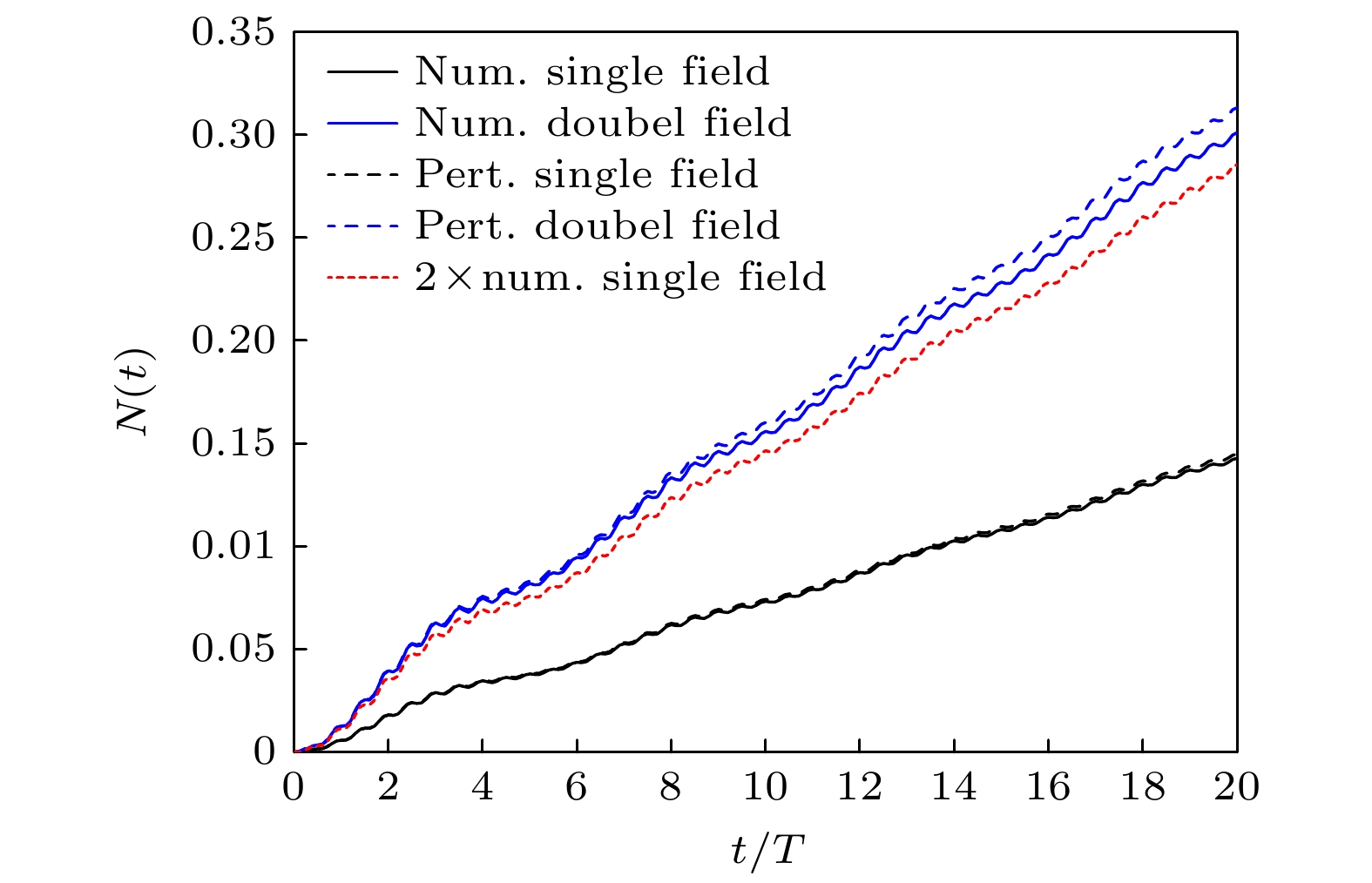
 DownLoad:
DownLoad:
